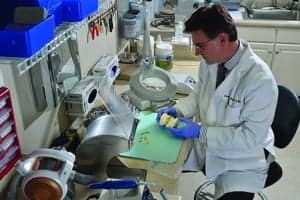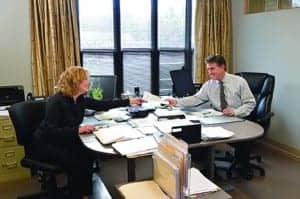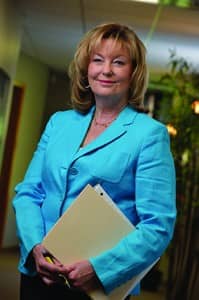Contributing founders Rob Rogers, DMD, DABDSM, and Mary Beth Rogers mark the 25th anniversary of the American Academy of Dental Sleep Medicine.
When Rob Rogers, DMD, DABDSM, graduated from the University of Pittsburgh School of Dental Medicine and launched his dental practice, now the Pittsburgh Dental Sleep Medicine Network, the field of dental sleep medicine did not exist. Sleep medicine itself was still a relatively young science. And when Mary Beth Davis (now, Mary Beth Rogers), vice president and director of administrative services for the Pittsburgh Dental Sleep Medicine Network, graduated from the University of Pittsburgh with a Bachelors of Science in education, the American Academy of Dental Sleep Medicine (AADSM) did not exist. Indeed, the American Academy of Sleep Medicine (AASM) had just been founded the year before in 1975. But the winds of change could be heard—including in the childhood home of Mary Beth.
With her father a lifelong snorer, both of Mary Beth’s parents complained of fatigue. “I had serendipitously taken one of the very first courses in sleep apnea and came home with a very rudimentary ‘boil and bite’ appliance that I asked my father-in-law to try. And he did,” Rob says.
The results were immediate. Mary Beth’s father had a soundless night, and her mother was an instant convert. “I thought, ‘We have something going here,’” Rob says.
The Early Days

Continued research on topics such as short- and long-term effectiveness, patient selection, and efficacy prediction is critical to further the development of dental sleep medicine, Rob says.
At the time, there weren’t many courses and not much literature in the field of dental sleep medicine—“the term was not even coined back then,” Rob says—but he researched as much as he could. The more he read, the more disturbing facts he learned. Untreated sleep apnea is incredibly dangerous, putting patients at high risk for cardiovascular problems; increased risk for conditions such as high blood pressure, stroke, and diabetes; decreased libido; and “the list goes on and on,” he says.
Because patient compliance with CPAP (continuous positive airway pressure) devices is not high, Rob saw an opportunity to help these patients in the same way he had helped his father-in-law. “CPAP is an excellent treatment modality, but I realized that dental appliances could play a positive role if we could get some good devices with a good protocol,” Rob says.
He began to reach out to the physicians in the area to let them know that he could treat sleep apnea, but he found it was a hard sell. “When we told physicians that we would be happy to work with them to treat sleep apnea in patients not using their CPAP, they would ask us to show them research, and we didn’t have any,” Rob recalls. Everything about the science was still in early development, from the initial protocols and testing to treatment and technology to follow-up and research.
There were other obstacles as well. The field had no visibility within the public so that patients didn’t know dental sleep medicine was an option. And if they did, there were no reimbursement codes to help them pay for it. “Insurance companies had no idea if the treatment was effective,” Rob says.
So he began to follow the research and collect data. He and other pioneers started working with the existing technology and its manufacturers to refine the devices and figure out how to use them effectively—and eventually they all began to work together.
From “Study Club” to Society
[metaslider id=146094]
“When I started working with my first appliances, I came into contact with four or five other dentists in the nation also working with rudimentary devices and having some degree of luck,” Rob says. The group decided to join forces and conducted a conference call once a month.
Together, they began to pioneer the use of appliances produced by others, determining how to use them effectively, how to dovetail with physicians and insurance companies, how to reach out to and manage patients, how to get better results, and eventually how to use the research that was evolving over time to elicit better patient response.
“Initially, we called it ‘study club,’ and as the months went by, we thought we should reach out and ask other dentists if they wanted to participate,” Rob says. So in 1991, the small group placed an ad within the Journal of the American Dental Association (JADA) promoting the launch of the Sleep Disorders Dental Society (SDDS) and seeking members. “Thirty to 40 people were interested and even paid a few dollars, and our five-person study club turned into a society,” Rob says.
Rob was named president and brought his wife Mary Beth on board when the two realized it was too large a workload for one person, however driven. “Rob was having a hard time seeing patients, managing his dental practice, and managing the organization, so he asked me if I could give him a hand with some of the administrative work. I said I would be happy to help, thinking I would take it on for a year at the very most,” Mary Beth says.
She was still on board a year later as the first executive director when the new organization held its inaugural annual meeting, drawing 25 attendees to Phoenix, Ariz. “We were in a small hotel with no vendors, no speakers, sitting together, drinking coffee, and talking,” Rob recalls. Fast-forward 25 years later.
The AADSM expects to draw more than 1,100 attendees—including a large portion of its 3,000-plus members—to its 25th Anniversary Meeting in Denver, from June 9 to 11, 2016. More than 70 exhibiting companies will fill the exhibit hall, and education will include coursework, symposia, discussion groups, case work, and clinical workshops by professionals in dental sleep medicine and sleep medicine. “In those early years, we were not sure if the organization would survive, and now, here it is, taking on a life of its own. It’s really fun for us,” Mary Beth says.
“Overnight” Success
As the AADSM has grown, so too has the discipline it represents. Much of the movement was driven forward by the SDDS, which in embracing this larger role ultimately became the American Academy of Dental Sleep Medicine. While the success of the organization can be described as jaw-dropping, the path was not without significant obstacles.
Mary Beth recounts one of the biggest challenges was keeping the organization solvent through its early years. “[Dental sleep medicine] was such a new field that we weren’t sure what would happen, but as more published literature came to light, we all became more committed to the growth and development of the field for the benefit of patients,” she says.
She recalls how the first 10 years involved a tremendous amount of work and that all of the board members took on more than they had time to do to help the field grow. “It was those early members who provided the commitment to push this field forward,” Mary Beth says.
Continuing Education Development
One of the first goals that received focus, and continues to do so, is education. “Hundreds of dentists are getting on board every year, and we need to bring along the education process to the point where they are very competent and recognizable as competent,” Rob says. The AADSM has offered various programs to fill educational gaps and meet the differing levels of expertise, from a remodeled study club that offers 7 sessions for dentists new to dental sleep medicine to the development and endorsement of board certification for the discipline. Currently, the AADSM recognizes the Diplomate status granted by the American Board of Dental Sleep Medicine (ABDSM).
Established in 2004, the ABDSM is an independent board of examiners for duly licensed dentists who treat sleep-related breathing disorders. Its purpose, as stated on the ABDSM website, is to “help set standards for the scope of dental sleep medicine, which includes oral appliances and upper-airway surgery to treat sleep-related breathing disorders, such as snoring and obstructive sleep apnea (OSA), and to assure professional dental and medical colleagues, patients, and the public of an acceptable level of education, training, and experience by those who become Diplomates of the ABDSM by examination.”
The program evolved from the original certification program developed by the AADSM; Rob served on the committee that was instrumental in delivering its course work certification criteria. ABDSM-certified professionals (DDS or DMD) demonstrate their knowledge via an examination, as well as work with a board-certified sleep physician at a sleep center and submitting letters of recommendation from board-certified sleep physicians and patient case presentations. Achieving Diplomate status implies a high level of skill and ability as with other boards.
This year, the AADSM is unveiling a new program designed to bridge the gap left between the experts with board certification and those brand new to the field. Information on the innovative program of “Qualified Dentist designation” was released to members in April.
The new designation was developed to allow dentists to demonstrate to physicians, and other interested parties such as insurance companies, that they have a “minimum standard and understanding of the science and technology driving dental sleep medicine along with a commitment to acquire more.” Rob says, “By 2018, only dentists with the Qualified Dentist designation, ABDSM board certification, or AADSM Facility Accreditation directorship will be included within the listings available on the ‘Find-a-Dentist’ directory on the AADSM website.”
Nascent Field to Respected Discipline
The requirement is intended to ensure that those providing services in the field are aware of the most up-to-date techniques and state-of-the-art technology. Dental sleep medicine may still be a new science, relatively speaking, but it has come a long way over the past 25 years. Today, Rob notes dental sleep practitioners have research, treatment protocols, improved technology, physician support, patient knowledge, increased collaboration, and insurance reimbursement to help guide their practice decisions.
“Today, we see physicians seeking out dentists to work with their CPAP-intolerant patients or patients who are not good candidates for CPAP, and that has been a big evolution,” Mary Beth says. These physicians can include general practitioners and sleep specialists, as well as cardiologists, endocrinologists, and other specialists.
“They all know that sleep is critical and are looking for dentists to join their teams,” Rob says. The recent publication of the first-ever joint clinical guidelines between the AADSM and the AASM1 represents a milestone for dental sleep medicine, underscoring the vital role oral appliance therapy now plays in treating OSA and positioning dentists as important players on integrated sleep teams.
“Although CPAP therapy is still the first-line option for treating OSA, oral appliance therapy is an effective alternative that is preferred by some patients. Sleep medicine physicians and dentists can promote high-quality, patient-centered care by working together to identify the optimal treatment for each patient who has sleep apnea,” says Nathaniel Watson, president of AASM, in releasing the new guidelines.
Breaking the Code
Payors agree as well, and now offer reimbursement codes for dental sleep medicine services. Prior to the code that is currently used, developed by Medicare in 2006, it was difficult for dentists to get paid through insurance companies, Mary Beth recalls. But even with the new coding, there is still room for improvement.
Most dentists can only work with insurance companies as out-of-network providers, according to Mary Beth. But AADSM is trying to push progress on their inclusion as in-network providers by offering opportunities for dental sleep medicine practitioners to meet the often stringent insurance carrier criteria. Its efforts include programs, such as support of board certification and the new Qualified Dentist designation, as well as offerings like the AADSM Dental Sleep Medicine Facility Accreditation program.
“When we first began to work closely with insurance providers through our practice here in the Pittsburgh area, the first thing we were asked is ‘How do we know that you will be a good provider and should be in our network?’” Mary Beth says. So she brought the idea of facility accreditation to the AADSM. “It’s a critical element that dentists need to work with insurance carriers,” Mary Beth says, noting it represents standardized guidelines, rigorous protocols, high office standards, and practiced clinical skills.
Living the Dream
Rob believes continued research is another element critical to further development in the field, whether working with insurance carriers, medical providers, or patients. “We need to know more about the effectiveness of appliances, in both the short and long term,” he notes.
Patient selection and prediction are key. “These treatments are not effective for everyone, so a major step is to figure out how to choose patients that we’re fairly confident are going to respond before we start so we don’t waste time and resources,” Rob says.
Recent advances in this area include monitors designed to test whether an oral concept will work for a specific patient, improved technologies in digitizing images of teeth, and enhanced printing and production capabilities. “We can increase our accuracy, fit, limit adjustment, and make [oral appliances] more comfortable for patients,” Rob says.
This is exciting because improvements such as these can have a positive impact not only on the physical results but also on patient compliance, further adding to a treatment’s effectiveness. Insurance companies want this data too, primarily to ensure they’re paying for something that is actually used. “We don’t quite know about adherence. Does the patient use it every night? Do they use it for years on end or sporadically?” Rob asks. New technology is available here as well. Rob describes thumbnail-sized monitors that can be placed within the plastic of an appliance to produce data on use. The next steps will be to collect and analyze the data.
Whether a patient chooses to follow treatment recommendations, many are happy to have the option. The Rogers say patients often ask why they weren’t given a choice before coming to them. Many stumble upon a dental sleep medicine specialist independently of their general physician or are referred as a later resort. And after the discovery, many finally get a rest from the nightmare of sleep apnea.
Rob notes that about three-fourths of patients who provide feedback report feeling better. Snoring is gone, fatigue has decreased, spouses are happy, their personal productivity is up. “Very often they say they’ve gotten their life back. As dentists, we’re used to helping people, but when we are able to help them sleep and breathe better, the impact and reward are amazing,” Rob says. Mary Beth’s mother agrees.
Renee Diiulio is a Los Angeles-based journalist. Her work with Sleep Review and interviews with experts like the Rogers provide education, inspiration, and an evidence-backed reason to get more sleep.
REFERENCE
1. Ramar K, Dort LC, Katz SG, et al. Clinical practice guideline for the treatment of obstructive sleep apnea and snoring with oral appliance therapy: an update for 2015. J Clin Sleep Med. 2015;11(7):773–827.
Dentists can subscribe to Sleep Review for free at www.sleepreviewmag.com/subscribe.








